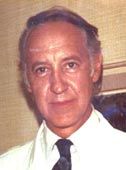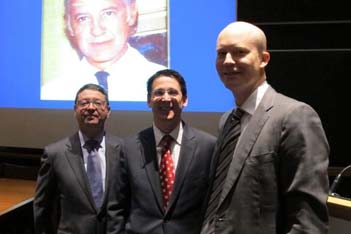Palmer Lecture: Why
Give 2 when 1 Will Do?

John Palmer
|
Lorne Rotstein gave a delightful
sketch of the character and
career of Dr. John Palmer, who
trained at the University of
Toronto in General and Plastic
Surgery, and then studied plastic
surgery, surgical oncology
and colorectal surgery at St.
Marks. A superb technician, he
was also somewhat of a maverick,
an artist, and an antique
shop owner. The lectureship was endowed by his friends
and family.
Alan Okrainec introduced Palmer Lecturer Tim
Pawlik who completed his undergraduate studies at
Georgetown, medical school at Tufts, surgical residency
at Michigan, and Ethics and Theology at Harvard. He
serves on the Ethics Committee of the Johns Hopkins
Hospital. He has published over 400 articles, given 250
talks, is the President of the Association for Academic
Surgery, and the John Cameron Professor of Surgery at
Hopkins.
Tim focused his lecture on the topic of perioperative
transfusion. Five million patients receive transfusions in
the United States, a total of 14 million units of blood per
year. It is the number one overutilized therapy in the US,
ahead of cardiac stents, polyethylene ear drainage tubes,
and scheduled births. With his anaestheologist colleague
and Head of Blood Bank Services Steve Frank, Tim has
studied how to decrease unnecessary transfusions, save
money and improved outcomes related to transfusion.
Most of the severe complications associated with
transfusion, such as Hepatitis B, C and HIV are now
rare, but other complications and cost can be associated
with unnecessary blood transfusions. Immunological
effects are more prevalent, including allergy and depression
of the immune response, which has been linked to
increases in cancer recurrence and metastasis. Data have
shown an increase in wound infections, and perhaps
even worse long-term survival among cancer patients
who have received a transfusion.
|
Decreasing the use of transfusion among surgeons can
be challenging. Pawlik noted that surgeons who give
a lot of blood tend to say that they are doing bigger
operations, have a different case mix, and sicker patients
than those who give fewer. In order to avoid problems
with individual surgeon case mix, Pawlik notes that
transfusion utilization may be better understood in
terms of hemoglobin triggers and targets. For example,
the trigger for transfusion is ideally between 7-8 grams
of hemoglobin. Those who trigger a transfusion above
that level are viewed as liberal, and lower triggers reflect
a restrictive practice. Randomized trials support the safe
use of a more restrictive target.
|
Tim reported on Hopkins patients undergoing surgery
for pancreatic, hepatic and colorectal disease from 2010-
2013. Among the eight surgeons in his division, there were
some who used a liberal and some a restrictive trigger. In
addition to provider level variation, factors associated with
increased use of transfusions included older age, co-morbidities,
male sex, and Whipple operations. Provider level
variation, even after taking all these factors into account,
was still considerable. In fact, Pawlik noted that there was
overutilization in 25% of cases and a 3 gram variation
among surgeons and anesthesiologists at Hopkins regarding
what trigger was used to implement a transfusion. Of
note, the C:T ratio - the ratio between the cross-matched
and transfused blood, which should ideally be about 2, also
varied considerably Some surgeons and anesthesiologists
had a C:T ratio of 1, while other had a C:T as high as 6.
The waste and cost of processing can be reduced by posting
these results. The variation was similar in the use of “yellow
blood” (i.e. fresh frozen plasma and platelets). A liberal
hemoglobin trigger in the operating room was associated
with liberal triggers in the postoperative period, suggesting
the surgeon as the most important driver of transfusion
behavior. Pawlik also described a spectrum in the use of
crystalloid, as some surgeons were liberal and some restrictive
in how much crystalloid fluids were given.
|
The effects of unnecessary transfusions are not inconsequential.
Pawlik described how the immunological
effects of transfusion can include more infections in
patients treated with a liberal trigger. Complications also
seem to be increased if the delta hemoglobin [the drop in
hemoglobin from the admission level to the postoperative
level] is 40% or greater. Oncologic outcomes also seem to
be impacted by transfusions, as some reports have noted
in increase in recurrent cancer among patients receiving
more transfusions. Even when patients do need a transfusion
the minimal amount necessary should be given.
“The notion that we should always give 2 transfusions if
we are going to give 1 is anachronistic. ‘Why give 2, when
1 will do?’ is the current recommendation. Furthermore,
each unit costs $220 , with a total delivery cost of $760 to
transfuse. The hepatobiliary group can save $100,000 per
year by adopting a restrictive policy – a potential saving of
$250, 000 if adopted by the entire Surgery Department.

left to right- Lorne Rotstein, Tim Pawlick, Alan Okrainec
|
“Some remedial steps to decrease transfusion include
pre-habilitation - treating anemia with iron preoperatively,
the use of minimally invasive access, the cell saver, reducing
phlebotomy for blood tests and setting the threshold
for transfusion at 7.5-8 grams for blood transfusion and
50,000 for platelets. In addition, implementing order entry
system guidelines, which remind surgeons that they are
recommending transfusion above the ideal threshold, can
be helpful.” One of the most effective techniques that Tim
describes was to provide unblinded data with the names
of the surgeons and anesthesiologist identifying different
providers’ transfusion utilization. By providing individual
surgeons their specific data on transfusion, Tim noted how
surgeons have changed their practice. In fact, the famed
John Cameron has dramatically reduced his transfusion
rate in the past 5 years by applying a more restrictive trigger.
Alan Okrainec asked about including the transfusion
recommendations in the timeout prior to surgery. Tim
says to the anaestheologists at that time: “Tell me if you
are going to hang blood or pressors.” Jim Rutka asked if
medico- legal fears lead to increased transfusions in the
\US. Tim felt overuse was more cultural than medicolegal.
Tom Waddell asked about real time feedback as
this aggregated data does not return to the surgeon
immediately following operations. Tim answered that
feedback is given in personal conversations, but is not
currently available on such a short time axis.
In conclusion, the variation is surgeon related. 25% of
transfusions are unnecessary and there is no increase in
complication when transfusions are restricted. A restrictive
policy reduces risk, reduces cost, and improves outcome.
M.M.
|